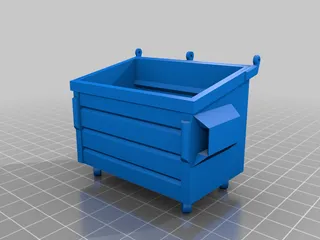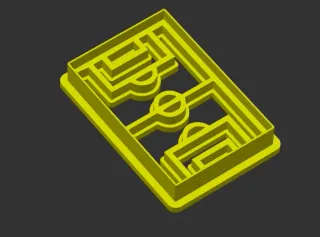Espada Tizona del Cid extensible - Print in place El Cid's Tizona sword (collapsible
Description
PDFLa espada Tizona es una d las espadas portadas por Rodrigo Díaz de Vivar, El Cid Campeador, según reza el Cantar de Mio Cid. Su segunda espada era la Colada.
El fichero de fusion360 está disponible para quien lo necesite. No lo subo debido al tamaño que tiene.
He usado filamento PLA 870 y aplicado un tratamiento térmico para aumentar la resistencia y que soporte los golpes de un niño.
La empuñadura se ha adaptado de los diseños de txus360 and riojaonly, la hoja es un diseño extensible en fusion360.
Tizona (also Tizón) is the name of one of the swords carried by Rodrigo Díaz de Vivar, El Cid, according to the Cantar de Mio Cid. The name of the second sword of El Cid is Colada.
Fusion360 project is available for anyone who needs it, I cannot upload it due to the huge size.
It's been printed in PLA 870 and applied thermal curing in order to make it stronger, as it has been printed for a 4yo kid.
the grip is an adaptation of txus360 and riojaonly designs, the sheet has been designed in fusion360.
Print Settings
Printer:
Artillery Genius
Rafts:
Yes
Supports:Yes
Resolution:
0.2
Infill:20%
Filament: Sakata PLA 870 White Post-Printing
PROCESO DE TEMPLADO - TEMPERING PROCESS
Metodo con horno - Oven process
Estos son los puntos principales para poder utilizar nuestro horno de
casa.
Recordemonos que, a menos que sea un horno de altísima calidad, los hornos tradicionales tienen
una variación de temperatura entre 20 y 40 grados en las fases de encendido y apagado, así que
SIEMPRE usaremos la temperatura mas baja que tengamos a disposición porque es la mas estable
(50-60 grados Celsius)
JAMAS utilizaremos el sistema de ventilación ( o horno con convección ), SIEMPRE el horno
tradicional con resistencias superior e inferior.
Pondremos la pieza con el cristal de la impresora a horno apagado y dejaremos que el horno se
caliente. Empezaremos a contar los minutos en el momento que el horno haya llegado a la
temperatura deseada.
Una vez se haya acabado el tiempo de templado, dejaremos que la pieza se enfríe durante unos
minutos abriendo un poco la puerta del horno (cuanto mas dejemos la pieza, cuanto mas seguros
estaremos de que la pieza se vaya enfriando progresivamente y que la parte mas interna de la
pieza este fría, y así evitaremos dejar huellas o deformar nuestro proyecto).
Una vez fria, podremos separar los soportes y la pieza de la base de cristal.
These are the main points to use the oven of our kitchen.
Remember that, unless it is a very high quality oven, traditional ovens have a temperature variation
between 20 and 40 degrees between the on and of phases, so ALWAYS use the lowest
temperature available because it is the most stable (50-60 degrees Celsius)
NEVER use the ventilation system (or oven with convection), ALWAYS the traditional oven with
upper and lower heating elements.
We will put the piece with the glass of the printer inside the oven still of and we will let the oven
warm up. We will start counting the minutes when the oven has reached the desired temperature.
Once the tempering time is over, let the piece cool down for a few minutes by opening the oven
door a bit (the more we leave the piece, the more sure we will be that the piece will gradually cool
down and that the inner part of the piece is cold, and thus avoid leaving traces or deform our
project).
Once cool, we can separate the supports and the piece from the glass base.
Metodo con agua
Water process
El método con agua suele ser el mas fácil y el mas seguro visto que tenemos un mejor control de la
temperatura de templado.
Llenaremos nuestro recipiente de agua midiendo con cuidado la temperatura.
En este caso utilizaremos un termómetro de casa parta poder medir la temperatura del agua
alrededor de los 70 grados.
Procedemos a sumergir la pieza con la base de cristal en nuestro recipiente, prestando atención a
que la pieza esté totalmente sumergida ( si la pieza tiene un porcentaje de relleno muy bajo,
tenderá a flotar. Por esto, utilizaremos unos pesos para que nuestro proyecto se quede en el fondo
del recipiente, prestando cuidado a que los pesos no toquen la pieza).
Esperaremos a que el agua esté fría (menos de 20 grados) y procederemos a separar los soportes
y la pieza de la base de cristal.
The method with water is usually the easiest and the safest since we have a better control of the
tempering temperature.
We will fill our water container by carefully measuring the temperature.
In this case we will use a home thermometer to measure the water temperature around 70 degrees.
We proceed to submerge the piece with the glass bed in our container, paying attention that the
piece is totally submerged (if the piece has a very low fill percentage, will tend to float. For this we
will use some weights to help out project to stay at the bottom of the container, taking care that the
weights do not touch the piece).
Wait until the water is cool (less than 20 degrees) and proceed to separate the supports and the
piece from the glass bed.
Category: CostumeTags
Model origin
The author marked this model as their own original creation. Imported from Thingiverse.




